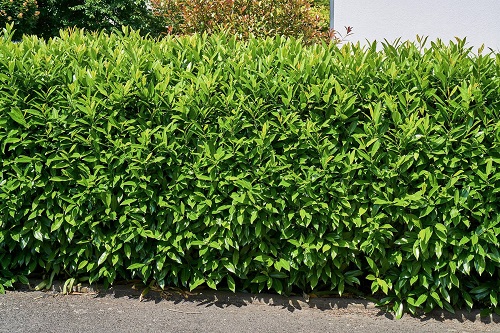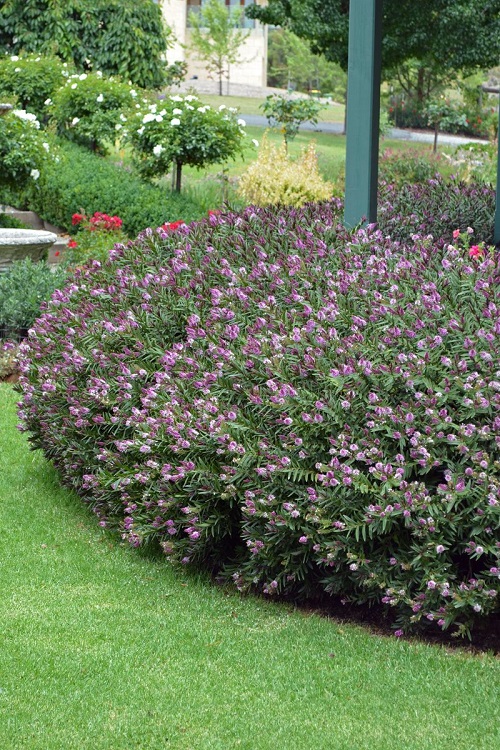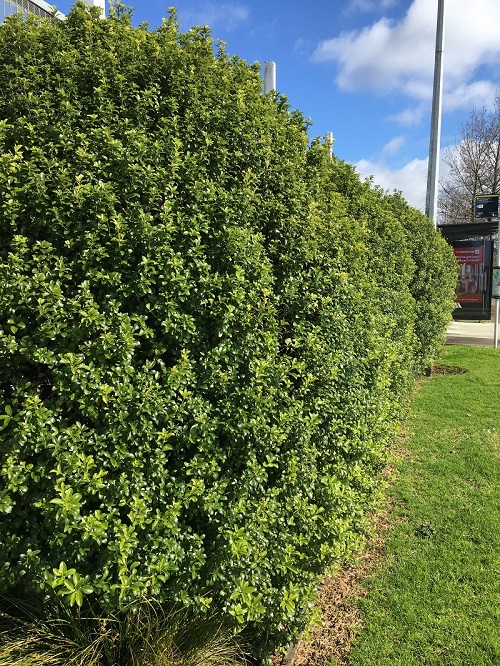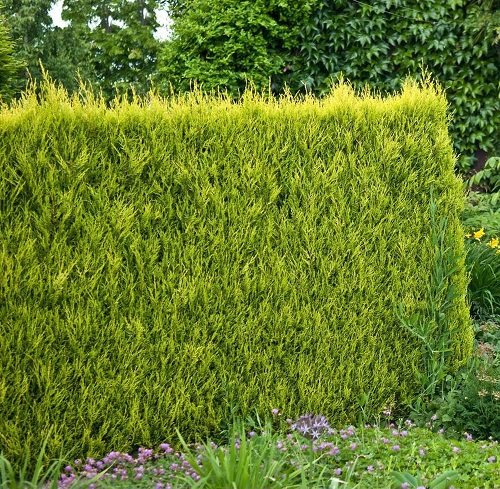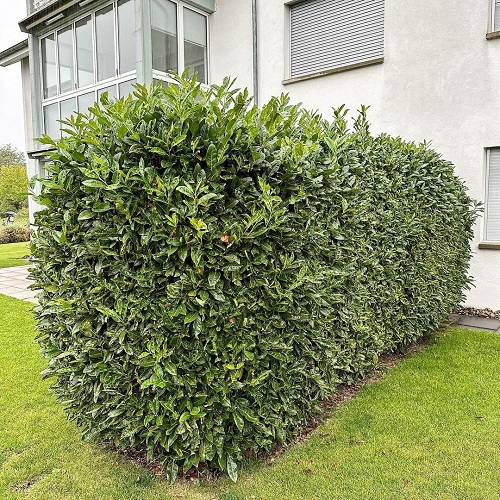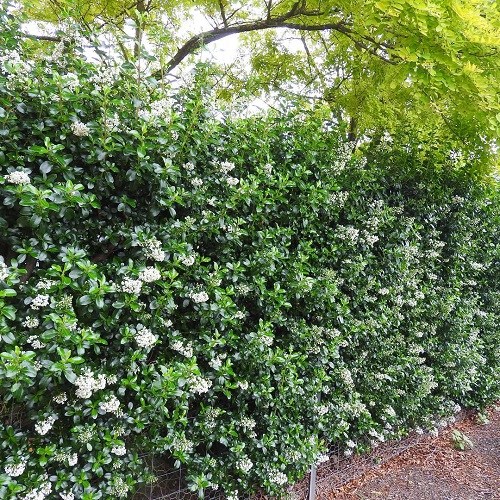These Frost Resistant Hedge Plants won’t be deterred by the chilly weather and continue spreading their pretty foliage!
Looking for a hardy hedge that can withstand harsh winters? Well, these frost-resistant hedge plants can be used for creating privacy and defining boundaries, even in colder climates. Don’t miss out!
Frost Resistant Hedge Plants
1. Bay Laurel
Botanical Name: Laurus nobilis ‘Bay Laurel’
USDA Zones: 8-11
This Mediterranean herb is an excellent choice for a bushy evergreen hedge, especially if you live near the coast. The fragrant leaves are perfect for cooking.
It also makes a good shrub or topiary plant and grows best in a warm, sunny spot. You will love the pale yellow flowers, which give this mildly frost-tolerant hedge a better appearance.
Despite its beauty and frost tolerance, you must take certain precautions while growing this plant. It is toxic to cats, dogs, and horses, so be careful if you are a pet parent and have any of these roaming around. Don’t worry; they won’t be severely harmed even if they nibble a bit.
2. Boxwood
Botanical Name: Buxus sempervirens
USDA Zones: 5-9
You don’t have to worry about bone-chilling winters when you have a hardy plant like boxwood, which can tolerate temperatures down to -15 F (- 26 C). Whether it’s cold wind or snow, a boxwood hedge will withstand any extreme and keep your garden looking its best.
Boxwood is pretty low-maintenance and can grow in various soil and light conditions. It can grow up to 20 feet, but you can prune it in tons of shapes to make it the focal point of the lawn. Try these boxwood planting ideas to boost your curb appeal.
3. Hebe
Botanical Name: Hebe spp.
USDA Zones: 6-11
Hebe hedges are the perfect combination of frost tolerance and beautiful colors. Growing these plants will give you beautiful pink, purple, and blue flowers that add class to medium hedging, containers, and cottage gardens.
Plant the shrub under partial sun and give it moist, well-draining soil for optimal growth. Remember to water it thoroughly during drought periods to keep it healthy. It’ll easily survive the frost.
4. Cheesewood
Botanical Name: Pittosporum spp.
USDA Zones: 8-11
Cheesewoods are fast-growing hedge plants, and they are also cold and frost-tolerant. You might take them for granted for their small leaf size, but rest assured that they can form excellently dense hedges once they grow. The best part is their light green foliage that shines under the sun.
They are great for sheltered, sunny locations and need well-drained soil because they quickly catch root rot. They’re frost-hardy down to 17 F (-8 C).
5. Castlewellan Gold
Botanical Name: Cupressocyparis ‘Castlewellan Gold’
USDA Zones: 5-9
Castlewellan gold is actually a tree that can grow as tall as 40 feet. But it is mainly used as a tall hedging and screening plant and pruned to a height of about 6-10 feet. You should go for it if you have a large estate or backyard and want a tall hedge. Although it produces no flowers, its dense growth makes up for it.
This hedge plant prefers cool climates, so frost is never a problem. Mindful pruning and watering during dry periods will ensure it thrives in your garden.
6. Portuguese Laurel
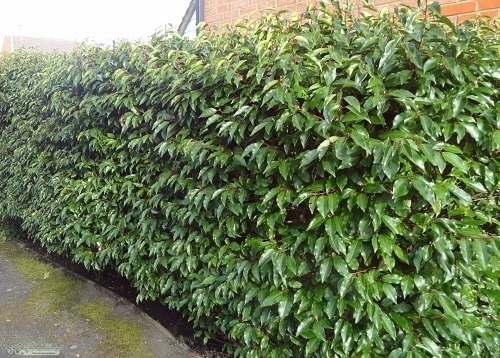
Botanical Name: Prunus lausitanica ‘Portuguese laurel’
USDA Zones: 6b-9
Portuguese laurel is a relatively slow-growing hedge plant with dark green foliage and white flowers. It is fantastic at resisting deer and thrives not only under cold and frost but also in high temperatures, which gives it an edge over others on our list.
If you are new to landscaping, you will love it. It grows well in poor soils and doesn’t demand much. However, its shallow roots can dry out quickly, so you must regularly water these hedges.
7. Cherry Laurel
Botanical Name: Prunus laurocerasus ‘Cherry Laurel’
USDA Zones: 6-9
This relative of Portuguese laurel has the same frost-resistant traits and is also deer-resistant. If you want a privacy screen, its dense foliage will do the trick. Unlike its relative, it is a fast-growing plant and blooms with sweet-smelling flowers in winter.
The cherry-like fruits of this plant provide visual interest and much-needed food for wildlife. To keep this hedge in the best shape, prune it in the late spring or early summer after the flowers have bloomed.
8. White Escallonia
Botanical Name: Escallonia Iveyi
USDA Zones: 7-9
White escallonia is the best choice for those in cold climates because of its frost tolerance. Its resilience is also demonstrated by its ability to stand light snow. Its beautiful glossy-green foliage and clusters of white flowers captivate from afar.
If you want long-lasting flowers and good health for your Escallonia, deadhead it regularly, and also apply at least 2-3 inches of mulch around the base of the plant.
Note: Escallonia rubra macrantha is hardy to USDA Zone 5, which means it can handle temperatures as low as -4 F (-20 C).
9. Robusta Photinia
Botanical Name: Photinia robusta
USDA Zones: 7-11
Robusta photinia has red-hued new growth that makes it a perfect combination of beauty and frost resistance. Gardeners who live in a moderately warm climate and need a quick, colorful hedging option can choose this one, as it can easily grow over three feet in a single year.
Give it a spot that offers full sun to part shade, and it will never disappoint you. Plus, all your neighbors would definitely envy its beauty.
10. Box Leaf Privet
Botanical Name: Ligustrum undulatum ‘Box leaf Privet’
USDA Zones: 7-11
Box leaf privet is a non-invasive evergreen shrub that can be used for hedges and screens in your garden. It is one of the most resilient plants, and it easily tolerates extreme heat and frost. If you want a thriving one, plant it in well-drained soil and boost the growth with a granular, slow-release fertilizer during the growing season.
It is also flexible in light requirements and can thrive in full sun and partial shade so that you can plant it in various garden areas without worry.
11. Japanese Holly
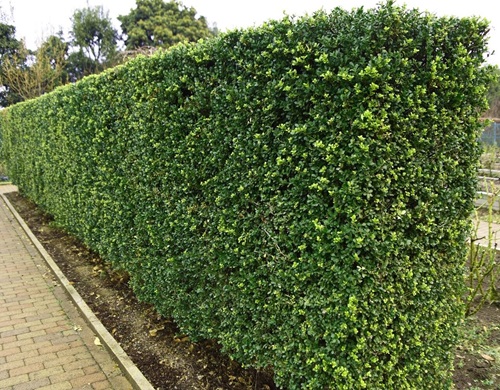
Botanical Name: Ilex crenata
USDA Zones: 5b-8b
Japanese holly is known for its glossy green foliage and dense growth habit. If you are planning to decorate your garden with low hedges, this is the perfect pick. It can reach up to 3-10 feet tall and 3-8 feet wide.
You can grow it in any ordinary soil, and because it tolerates semi-shade, you can easily plant it in protected areas of your garden.
12. Yew

Botanical Name: Taxus baccata
USDA Zones: 4-8
Yew can survive in extremely cold climates, so frost is not a problem. It produces red berries, which give it a festive appeal–that’s why you will often find it as a part of churchyards. Many gardeners use it during Christmas time, too.
If you want a healthy yew plant, fertilize it in the early spring, but do it with established ones that are at least one year old.


